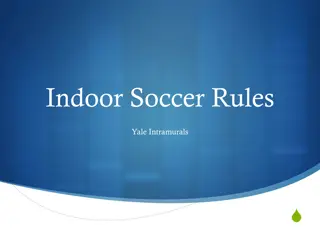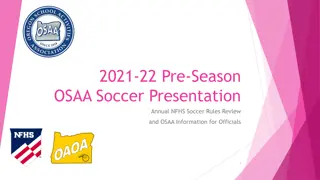Understanding the Magnus Effect in Soccer: A Comprehensive Analysis
Explore the Magnus Effect in soccer through a detailed examination of its physical examples, the physics behind it, mathematics of movement, and numerical methods for solution. Delve into real-world applications, such as Roberto Carlos' famous 1997 goal, to understand the impact of fluid dynamics and aerodynamics on projectile motion in sports.
Download Presentation

Please find below an Image/Link to download the presentation.
The content on the website is provided AS IS for your information and personal use only. It may not be sold, licensed, or shared on other websites without obtaining consent from the author. Download presentation by click this link. If you encounter any issues during the download, it is possible that the publisher has removed the file from their server.
E N D
Presentation Transcript
BEND IT LIKE MAGNUS: AN BEND IT LIKE MAGNUS: AN INSPECTION OF THE INSPECTION OF THE MAGNUS EFFECT IN SOCCER MAGNUS EFFECT IN SOCCER Michal Nowicki Edwin Perezic Zachary Conrad
Outline Basic Understanding of Effect 1. Physical Examples 1. Projectile Motion 2. Roberto Carlos 1997, Occidental Soccer 2015 2. Physics of effect 1. Fluid Dynamics and Aerodynamics 3. Mathematics of Movement 1. ODEs of projectile motion 2. Numerical Method for Solution: Runge-Kutta Method 3. Mathematica Modeling of solution
Introduction to Projectile Motion x = xo+vxot y = 0 z = zo+ vzot gt2 x -> displacement in x direction y -> displacement in y direction z -> displacement in z direction g -> gravity constant v -> initial velocity
Physical Examples Roberto Carlos 1997 Basketball
Fluid Dynamics Real world is not a vacuum Drag force and lift force Fl=-.5p|v|2Cl Lift coefficient Depends on spin Additional curvature of trajectory
ODEs of Projectile Motion x -> displacement in x direction y -> displacement in y direction z -> displacement in z direction kd -> drag coeffecient g -> gravity constant kl -> lift coeffecient -> angle between spin axis and ground plane (x,y plane) v -> initial velocity
Runge-Kutta Numerical Method Essentially a modified Eulers Method Weighted Averages Method used by Mathematica to solve ODEs For all three equations in the ODE x(t0)=0 y(t0)=0 z(t0)=0
Runge-Kutta Cont. y = f(t,y) y(t0)= n0 t0=0 Timestep= h k1=hf(t0,n0) k2=hf(t0+h/2,n0+k1/2) k3=hf(t0+h/2,n0+k2/2) k4=hf(t0+h,n0+k3) n1=n0+(k1+2k2+2k3+k4) 6
Mathematica Due to complexity of the system of ODEs we used Mathematica to solve and model this system
Conclusion Gained understanding of the effect of the Magnus Effect on the flight of a soccer ball Found ODEs for motion of a soccer ball Used Mathematica model to solve the ODEs of flight of a soccer ball Modeled famous free kicks such as Roberto Carlos 1997 using Mathematica























